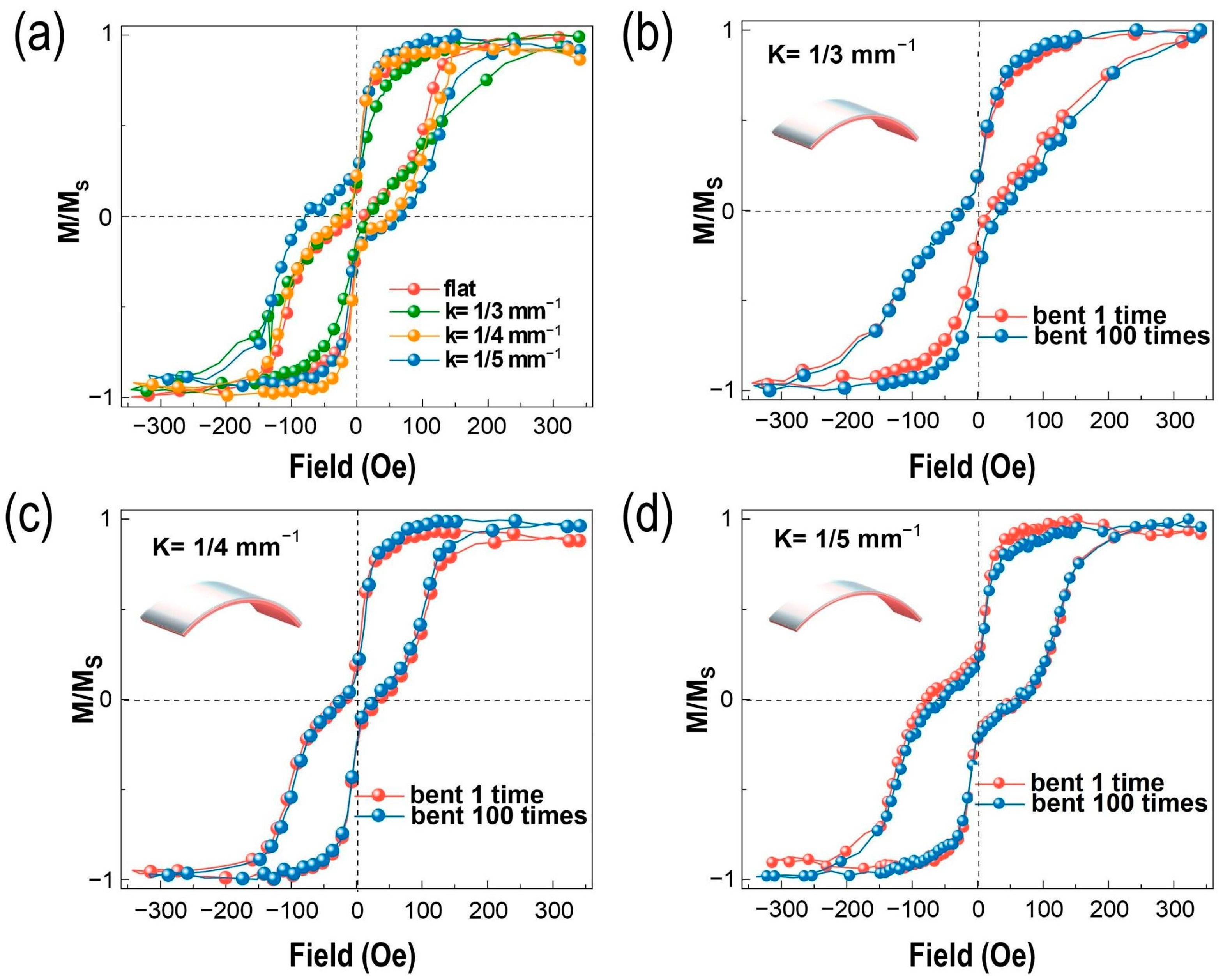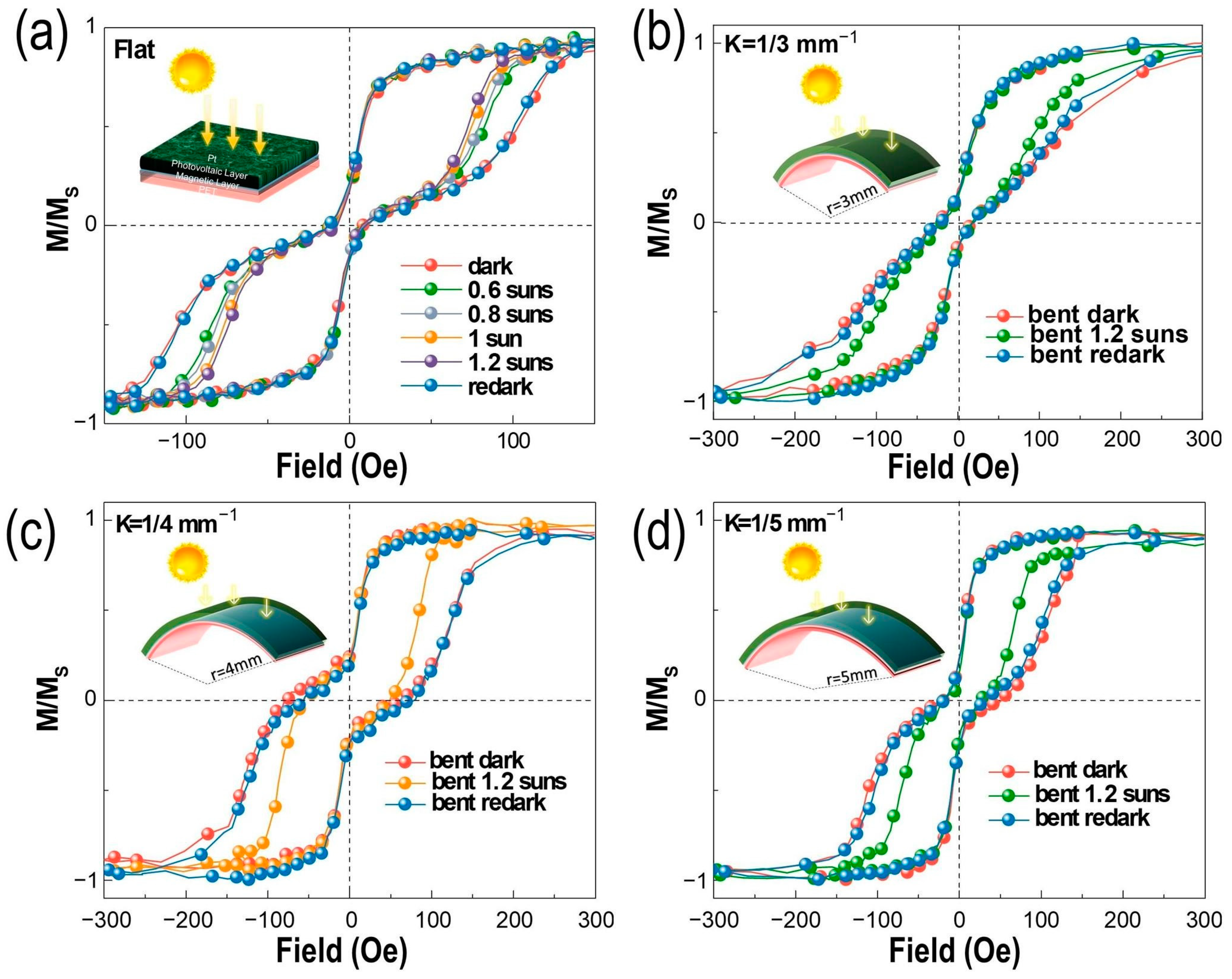Solar-Powered Switch of Antiferromagnetism/Ferromagnetism in Flexible Spintronics
Abstract
:1. Introduction
2. Results and Discussion
3. Conclusions
4. Experimental Section
4.1. Photovoltaic Layer Fabrication
4.2. Device Fabrication
4.3. In Situ Magnetic Property Measurement
Supplementary Materials
Author Contributions
Funding
Data Availability Statement
Acknowledgments
Conflicts of Interest
References
- Ota, S.; Ando, A.; Chiba, D. A flexible giant magnetoresistive device for sensing strain direction. Nat. Electron. 2018, 1, 124–129. [Google Scholar] [CrossRef]
- Vemulkar, T.; Mansell, R.; Fernández-Pacheco, A.; Cowburn, R.P. Toward Flexible Spintronics: Perpendicularly Magnetized Synthetic Antiferromagnetic Thin Films and Nanowires on Polyimide Substrates. Adv. Funct. Mater. 2016, 26, 4704–4711. [Google Scholar] [CrossRef]
- Kim, D.H.; Lu, N.; Ma, R.; Kim, Y.S.; Kim, R.H.; Wang, S.; Wu, J.; Won, S.M.; Tao, H.; Islam, A.; et al. Epidermal electronics. Science 2011, 333, 838–843. [Google Scholar] [CrossRef] [PubMed]
- Rogers, J.A.; Someya, T.; Huang, Y. Materials and mechanics for stretchable electronics. Science 2010, 327, 1603–1607. [Google Scholar] [CrossRef] [PubMed]
- Zhao, Y.F.; Du, Y.J.; Wang, L.; Chen, K.; Luo, Z.L.; Yan, W.S.; Li, Q.; Jiang, Z.D.; Liu, M.; Zhou, Z.Y. Sunlight-induced tri-state spin memory in photovoltaic/ferromagnetic heterostructure. Nano Today 2022, 46, 101605. [Google Scholar] [CrossRef]
- Li, M.; Li, C.; Xu, X.; Wang, M.; Zhu, Z.; Meng, K.; He, B.; Yu, G.; Hu, Y.; Peng, L.M.; et al. An Ultrathin Flexible Programmable Spin Logic Device Based on Spin-Orbit Torque. Nano Lett. 2023, 23, 3818–3825. [Google Scholar] [CrossRef] [PubMed]
- Wolf, S.A.; Awschalom, D.D.; Buhrman, R.A.; Daughton, J.M.; von Molnar, S.; Roukes, M.L.; Chtchelkanova, A.Y.; Treger, D.M. Spintronics: A spin-based electronics vision for the future. Science 2001, 294, 1488–1495. [Google Scholar] [CrossRef]
- Chen, Y.-f.; Mei, Y.; Kaltofen, R.; Mönch, J.I.; Schumann, J.; Freudenberger, J.; Klauß, H.-J.; Schmidt, O.G. Towards Flexible Magnetoelectronics: Buffer-Enhanced and Mechanically Tunable GMR of Co/Cu Multilayers on Plastic Substrates. Adv. Mater. 2008, 20, 3224–3228. [Google Scholar] [CrossRef]
- Ha, M.; Canon Bermudez, G.S.; Kosub, T.; Monch, I.; Zabila, Y.; Oliveros Mata, E.S.; Illing, R.; Wang, Y.; Fassbender, J.; Makarov, D. Printable and Stretchable Giant Magnetoresistive Sensors for Highly Compliant and Skin-Conformal Electronics. Adv. Mater. 2021, 33, e2005521. [Google Scholar] [CrossRef]
- Hu, H.; Zhang, C.; Pan, C.; Dai, H.; Sun, H.; Pan, Y.; Lai, X.; Lyu, C.; Tang, D.; Fu, J.; et al. Wireless Flexible Magnetic Tactile Sensor with Super-Resolution in Large-Areas. ACS Nano 2022, 16, 19271–19280. [Google Scholar] [CrossRef]
- Uhrmann, T.; Bär, L.; Dimopoulos, T.; Wiese, N.; Rührig, M.; Lechner, A. Magnetostrictive GMR sensor on flexible polyimide substrates. J. Magn. Magn. Mater. 2006, 307, 209–211. [Google Scholar] [CrossRef]
- Lee, Y.; Che, S.; Velasco, J., Jr.; Gao, X.; Shi, Y.; Tran, D.; Baima, J.; Mauri, F.; Calandra, M.; Bockrath, M.; et al. Gate-Tunable Magnetism and Giant Magnetoresistance in Suspended Rhombohedral-Stacked Few-Layer Graphene. Nano Lett. 2022, 22, 5094–5099. [Google Scholar] [CrossRef] [PubMed]
- Song, C.; Cui, B.; Li, F.; Zhou, X.J.; Pan, F. Recent progress in voltage control of magnetism: Materials, mechanisms, and performance. Prog. Mater. Sci. 2017, 87, 33–82. [Google Scholar] [CrossRef]
- Sasmal, A.; Arockiarajan, A. Recent progress in flexible magnetoelectric composites and devices for next generation wearable electronics. Nano Energy 2023, 115, 108733. [Google Scholar] [CrossRef]
- Ren, L.; Zhou, C.; Song, X.; Seng, H.T.; Liu, L.; Li, C.; Zhao, T.; Zheng, Z.; Ding, J.; Feng, Y.P.; et al. Efficient Spin-Orbit Torque Switching in a Perpendicularly Magnetized Heusler Alloy MnPtGe Single Layer. ACS Nano 2023, 17, 6400–6409. [Google Scholar] [CrossRef] [PubMed]
- Zhu, L. Switching of Perpendicular Magnetization by Spin-Orbit Torque. Adv. Mater. 2023, 35, 2300853. [Google Scholar] [CrossRef]
- Liu, B.; Xiao, H.; Weinelt, M. Microscopic insights to spin transport-driven ultrafast magnetization dynamics in a Gd/Fe bilayer. Sci. Adv. 2023, 9, eade0286. [Google Scholar] [CrossRef]
- Deng, Y.; Li, W.; Lan, X.; Zhang, E.; Li, R.; Shang, Y.; Liu, S.; Li, B.; Liu, X.; Zheng, H.; et al. Field-Free Switching of Spin Crossbar Arrays by Asymmetric Spin Current Gradient. Adv. Funct. Mater. 2023, 2307612. [Google Scholar] [CrossRef]
- Wu, H.; Zhang, H.; Wang, B.; Gross, F.; Yang, C.Y.; Li, G.; Guo, C.; He, H.; Wong, K.; Wu, D.; et al. Current-induced Neel order switching facilitated by magnetic phase transition. Nat. Commun. 2022, 13, 1629. [Google Scholar] [CrossRef]
- Velez, S.; Ruiz-Gomez, S.; Schaab, J.; Gradauskaite, E.; Wornle, M.S.; Welter, P.; Jacot, B.J.; Degen, C.L.; Trassin, M.; Fiebig, M.; et al. Current-driven dynamics and ratchet effect of skyrmion bubbles in a ferrimagnetic insulator. Nat. Nanotechnol. 2022, 17, 834–841. [Google Scholar] [CrossRef]
- Ryu, J.; Thompson, R.; Park, J.Y.; Kim, S.J.; Choi, G.; Kang, J.; Jeong, H.B.; Kohda, M.; Yuk, J.M.; Nitta, J.; et al. Efficient spin-orbit torque in magnetic trilayers using all three polarizations of a spin current. Nat. Electron. 2022, 5, 217–223. [Google Scholar] [CrossRef]
- Higo, T.; Kondou, K.; Nomoto, T.; Shiga, M.; Sakamoto, S.; Chen, X.; Nishio-Hamane, D.; Arita, R.; Otani, Y.; Miwa, S.; et al. Perpendicular full switching of chiral antiferromagnetic order by current. Nature 2022, 607, 474–479. [Google Scholar] [CrossRef] [PubMed]
- Han, L.; Wang, Y.; Zhu, W.; Zhao, R.; Chen, X.; Su, R.; Zhou, Y.; Bai, H.; Wang, Q.; You, Y.; et al. Spin homojunction with high interfacial transparency for efficient spin-charge conversion. Sci. Adv. 2022, 8, eabq2742. [Google Scholar] [CrossRef] [PubMed]
- Buttner, F.; Lemesh, I.; Schneider, M.; Pfau, B.; Gunther, C.M.; Hessing, P.; Geilhufe, J.; Caretta, L.; Engel, D.; Kruger, B.; et al. Field-free deterministic ultrafast creation of magnetic skyrmions by spin-orbit torques. Nat. Nanotechnol. 2017, 12, 1040–1044. [Google Scholar] [CrossRef]
- Brataas, A.; Kent, A.D.; Ohno, H. Current-induced torques in magnetic materials. Nat. Mater. 2012, 11, 372–381. [Google Scholar] [CrossRef] [PubMed]
- Avci, C.O.; Quindeau, A.; Pai, C.F.; Mann, M.; Caretta, L.; Tang, A.S.; Onbasli, M.C.; Ross, C.A.; Beach, G.S. Current-induced switching in a magnetic insulator. Nat. Mater. 2017, 16, 309–314. [Google Scholar] [CrossRef]
- Zhang, W.; Mazzarello, R.; Wuttig, M.; Ma, E. Designing crystallization in phase-change materials for universal memory and neuro-inspired computing. Nat. Rev. Mater. 2019, 4, 150–168. [Google Scholar] [CrossRef]
- Chiang, C.C.; Huang, S.Y.; Qu, D.; Wu, P.H.; Chien, C.L. Absence of Evidence of Electrical Switching of the Antiferromagnetic Neel Vector. Phys. Rev. Lett. 2019, 123, 227203. [Google Scholar] [CrossRef]
- Wang, L.; Feng, Q.; Kim, Y.; Kim, R.; Lee, K.H.; Pollard, S.D.; Shin, Y.J.; Zhou, H.; Peng, W.; Lee, D.; et al. Ferroelectrically tunable magnetic skyrmions in ultrathin oxide heterostructures. Nat. Mater. 2018, 17, 1087–1094. [Google Scholar] [CrossRef]
- Zhang, Z.; Liu, E.; Lu, X.; Zhang, W.; You, Y.; Xu, G.; Xu, Z.; Wong, P.K.J.; Wang, Y.; Liu, B.; et al. Strain-Controlled Spin Wave Excitation and Gilbert Damping in Flexible Co2FeSi Films Activated by Femtosecond Laser Pulse. Adv. Funct. Mater. 2021, 31, 2007211. [Google Scholar] [CrossRef]
- Tengdin, P.; Gentry, C.; Blonsky, A.; Zusin, D.; Gerrity, M.; Hellbruck, L.; Hofherr, M.; Shaw, J.; Kvashnin, Y.; Delczeg-Czirjak, E.K.; et al. Direct light-induced spin transfer between different elements in a spintronic Heusler material via femtosecond laser excitation. Sci. Adv. 2020, 6, eaaz1100. [Google Scholar] [CrossRef] [PubMed]
- Xie, C.M.; Dan, M.J.; Hu, G.W.; Liu, N.A.; Zhang, Y. Piezo-phototronic spin laser based on wurtzite quantum wells. Nano Energy 2022, 96, 107100. [Google Scholar] [CrossRef]
- Kirilyuk, A.; Kimel, A.V.; Rasing, T. Laser-induced magnetization dynamics and reversal in ferrimagnetic alloys. Rep. Prog. Phys. 2013, 76, 026501. [Google Scholar] [CrossRef] [PubMed]
- Wang, M.; Xu, H.; Wu, T.; Ambaye, H.; Qin, J.; Keum, J.; Ivanov, I.N.; Lauter, V.; Hu, B. Optically Induced Static Magnetization in Metal Halide Perovskite for Spin-Related Optoelectronics. Adv. Sci. 2021, 8, 2004488. [Google Scholar] [CrossRef] [PubMed]
- Willems, F.; von Korff Schmising, C.; Struber, C.; Schick, D.; Engel, D.W.; Dewhurst, J.K.; Elliott, P.; Sharma, S.; Eisebitt, S. Optical inter-site spin transfer probed by energy and spin-resolved transient absorption spectroscopy. Nat. Commun. 2020, 11, 871. [Google Scholar] [CrossRef] [PubMed]
- Harchol, A.; Barak, Y.; Hughes, K.E.; Hartstein, K.H.; Jobsis, H.J.; Prins, P.T.; de Mello Donega, C.; Gamelin, D.R.; Lifshitz, E. Optically Detected Magnetic Resonance Spectroscopy of Cu-Doped CdSe/CdS and CuInS(2) Colloidal Quantum Dots. ACS Nano 2022, 16, 12866–12877. [Google Scholar] [CrossRef] [PubMed]
- Higginbottom, D.B.; Kurkjian, A.T.K.; Chartrand, C.; Kazemi, M.; Brunelle, N.A.; MacQuarrie, E.R.; Klein, J.R.; Lee-Hone, N.R.; Stacho, J.; Ruether, M.; et al. Optical observation of single spins in silicon. Nature 2022, 607, 266–270. [Google Scholar] [CrossRef]
- Zhao, Y.; Zhao, S.; Wang, L.; Zhou, Z.; Liu, J.; Min, T.; Peng, B.; Hu, Z.; Jin, S.; Liu, M. Sunlight Control of Interfacial Magnetism for Solar Driven Spintronic Applications. Adv. Sci. 2019, 6, 1901994. [Google Scholar] [CrossRef]
- Li, C.L.; Li, Y.J.; Zhao, Y.F.; Du, Y.J.; Zhao, M.; Peng, W.J.; Wu, Y.Y.; Liu, M.; Zhou, Z.Y. Sunlight Control of Ferromagnetic Damping in Photovoltaic/Ferromagnetic Heterostructures. Adv. Funct. Mater. 2022, 32, 2111652. [Google Scholar] [CrossRef]
- Zhao, M.; Zhao, Y.; Li, Y.; Dong, G.; He, Z.; Du, Y.; Jiang, Y.; Wu, S.; Wang, C.; Zhao, L.; et al. Manipulations of Spin Waves by Photoelectrons in Ferromagnetic/Non-Ferromagnetic Alloyed Film. Adv. Mater. 2023, 35, 2303810. [Google Scholar] [CrossRef]
- Du, Y.J.; Zhao, Y.F.; Wang, L.; He, Z.X.; Wu, Y.Y.; Wang, C.Y.; Zhao, L.B.; Jiang, Z.D.; Liu, M.; Zhou, Z.Y. Deterministic Magnetization Reversal in Synthetic Antiferromagnets using Natural Light. Small 2023, 19, 2302884. [Google Scholar] [CrossRef] [PubMed]
- Zhao, M.; Wang, L.; Zhao, Y.; Du, Y.; He, Z.; Chen, K.; Luo, Z.; Yan, W.; Li, Q.; Wang, C.; et al. Deterministic Magnetic Switching in Perpendicular Magnetic Trilayers Through Sunlight-Induced Photoelectron Injection. Small 2023, 19, 2301955. [Google Scholar] [CrossRef] [PubMed]
- Liao, S.-H.; Jhuo, H.-J.; Cheng, Y.-S.; Chen, S.-A. Fullerene Derivative-Doped Zinc Oxide Nanofilm as the Cathode of Inverted Polymer Solar Cells with Low-Bandgap Polymer (PTB7-Th) for High Performance. Adv. Mater. 2013, 25, 4766–4771. [Google Scholar] [CrossRef] [PubMed]
- Liao, S.-H.; Jhuo, H.-J.; Yeh, P.-N.; Cheng, Y.-S.; Li, Y.-L.; Lee, Y.-H.; Sharma, S.; Chen, S.-A. Single Junction Inverted Polymer Solar Cell Reaching Power Conversion Efficiency 10.31% by Employing Dual-Doped Zinc Oxide Nano-Film as Cathode Interlayer. Sci. Rep. 2014, 4, 6813. [Google Scholar] [CrossRef]




Disclaimer/Publisher’s Note: The statements, opinions and data contained in all publications are solely those of the individual author(s) and contributor(s) and not of MDPI and/or the editor(s). MDPI and/or the editor(s) disclaim responsibility for any injury to people or property resulting from any ideas, methods, instructions or products referred to in the content. |
© 2023 by the authors. Licensee MDPI, Basel, Switzerland. This article is an open access article distributed under the terms and conditions of the Creative Commons Attribution (CC BY) license (https://creativecommons.org/licenses/by/4.0/).
Share and Cite
Wang, C.; Du, Y.; Zhao, Y.; He, Z.; Wang, S.; Zhang, Y.; Jiang, Y.; Du, Y.; Wu, J.; Jiang, Z.; et al. Solar-Powered Switch of Antiferromagnetism/Ferromagnetism in Flexible Spintronics. Nanomaterials 2023, 13, 3158. https://doi.org/10.3390/nano13243158
Wang C, Du Y, Zhao Y, He Z, Wang S, Zhang Y, Jiang Y, Du Y, Wu J, Jiang Z, et al. Solar-Powered Switch of Antiferromagnetism/Ferromagnetism in Flexible Spintronics. Nanomaterials. 2023; 13(24):3158. https://doi.org/10.3390/nano13243158
Chicago/Turabian StyleWang, Chenying, Yujing Du, Yifan Zhao, Zhexi He, Song Wang, Yaxin Zhang, Yuxuan Jiang, Yongjun Du, Jingen Wu, Zhuangde Jiang, and et al. 2023. "Solar-Powered Switch of Antiferromagnetism/Ferromagnetism in Flexible Spintronics" Nanomaterials 13, no. 24: 3158. https://doi.org/10.3390/nano13243158
APA StyleWang, C., Du, Y., Zhao, Y., He, Z., Wang, S., Zhang, Y., Jiang, Y., Du, Y., Wu, J., Jiang, Z., & Liu, M. (2023). Solar-Powered Switch of Antiferromagnetism/Ferromagnetism in Flexible Spintronics. Nanomaterials, 13(24), 3158. https://doi.org/10.3390/nano13243158






